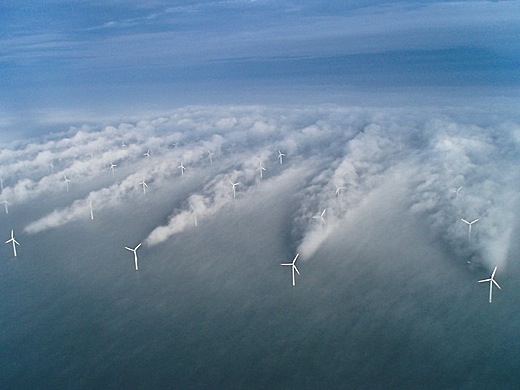By Chris Rhodes on 20 August 2011 for Scitizen -
(http://scitizen.com/future-energies/natural-limits-to-world-wind-energy-_a-14-3695.html)

Image above: The above photograph shows the turbulence field behind the Horns Rev offshore wind turbines. Horns Rev is located in the North Sea, 14 kilometers west of Denmark. Photographer Christian Steiness. From (http://wattsupwiththat.com/2011/04/28/the-wind-turbine-albedo-effect/).
From a thermodynamic analysis, it is estimated that the amount of energy available in the Earth system to be extracted by wind-turbines is limited at 18 - 64 TW, and far less than previous engineering-based estimates. If wind-power technology were expanded to a level of energy extraction comparable to that of human activities on Earth (17 TW), the world climate would be affected.
While presently only 0.03 TW of energy was extracted from wind in 2008, and there is room for a considerable expansion of this technology with relatively insignificant effects on the climate, any future expansion on the global scale must take account that the potential for extraction of wind energy is finite according to the nature of the Earth system.
It is thought too that as the atmospheric CO2 concentration increases, as it must with the continued burning of fossil fuels, the kinetic energy generation from the atmosphere will decrease thus further diminishing the amount of energy that may be sensibly extracted by wind-turbines on the very large scale.
The amount of energy available in the Earth system to be extracted by wind-turbines is limited, and if sufficient energy is removed the world climate will be affected. These striking conclusions follow from a recent analysis (http://www.earth-syst-dynam.net/2/1/2011/esd-2-1-2011.html) reported from the University of Jena in Germany. Humans use energy in total at a rate of 17 TW (terawatts), 87% of which is provided by fossil fuels. In the effort to mitigate carbon emissions and climate-change, sources of carbon-free renewable energy are sought, particularly wind-power.
From a simple engineering perspective, the more wind-turbines are placed around the globe, the more energy can be extracted, with no particular effect on the overall energy of the atmospheric flow. From the various simulations used it was inferred that between 18 - 68 TW of mechanical wind power can be extracted from the atmospheric boundary layer, taken over all non-glaciated land surfaces.
While a single wind-turbine does not affect the global atmosphere, the installation of a large number of such devices will interfere with the atmospheric circulation and diminish the extraction efficiency on the large scale, since any extraction of momentum will act in competition with natural wind-power energy dissipation by turbulence in the boundary layer. The amount of extractable energy evaluated using this "top-down" thermodynamic approach is significantly smaller than has been estimated using "bottom-up" engineering models based on wind turbine characteristics and wind velocity measurements which give values up to 1700 TW.
If wind-energy were extracted on the scale of human demand for energy (17 TW), amounting to 50 -95% of the total energy available, significant climatic effects are predicted. These are a result of increased turbulence and entrainment of air at higher altitudes by the simulated turbines. At higher altitudes the air is potentially warmer and heats the air nearer to the surface by mixing with it. The warming effect is similar to that predicted from an elevation of the atmospheric CO2 concentration to 720 ppm.
While presently only 0.03 TW of energy was extracted from wind in 2008, and there is room for a considerable expansion of this technology with relatively insignificant effects on the climate, any future expansion on the global scale must take account that the potential for extraction of wind energy is finite according to the nature of the Earth system. It is thought too that as the atmospheric CO2 concentration increases, as it must with the continued burning of fossil fuels, the kinetic energy generation from the atmosphere will decrease thus further diminishing the amount of energy that may be sensibly extracted by wind-turbines on the very large scale.
.
1 comment :
This is what i am looking for regarding Natural Limits to Wind Energy really you made my day.
Thanks for sharing........
wind turbine
Post a Comment